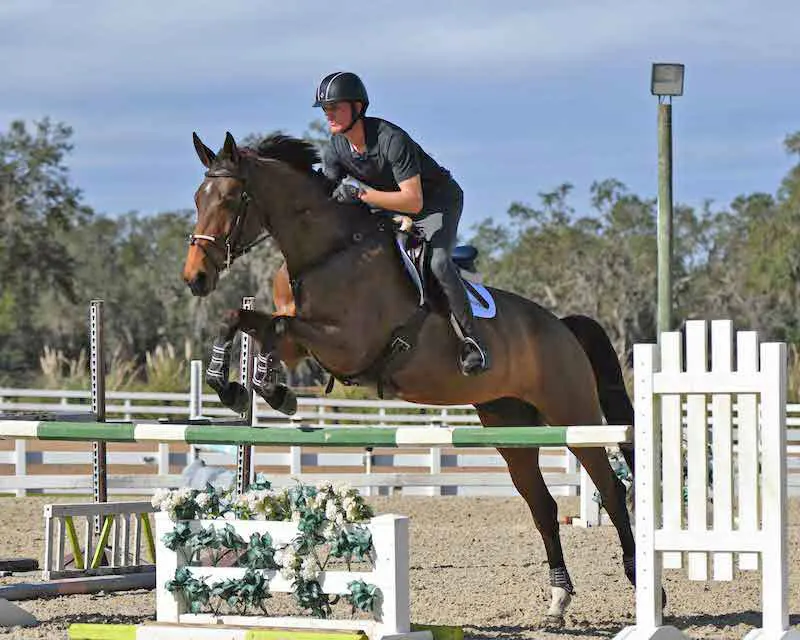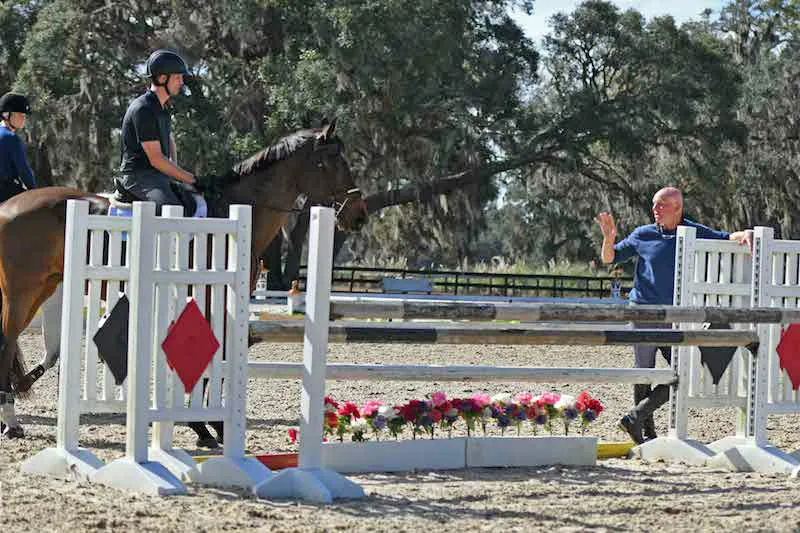After a challenging first day of dressage training at the U.S. Equestrian Emerging Athlete Eventing 25 Program Training Session, being held Jan. 8-11 in Ocala, Florida, riders turned their focus to show jumping.
Right off the bat, USEF Eventing Emerging Athlete Coach Leslie Law asked riders to warm up using the same exercises they’d utilized in dressage training the day before. “Forward, then collect. Forward, then collect. Now, shoulder-in,” he said.
“There’s not a big difference between preparing for dressage and preparing to jump—most of the exercises are similar and cross over,” he continued. “If you have an issue such as a poor connection, you have to face it now in the warm-up. Don’t avoid it or get angry—just address it and work through it. If you don’t go there, it’s sure enough going to happen as soon as you start jumping, and you never want to have a problem resurface when cantering down to a triple combination.”
One of the riders was William Zuschlag of Greenville, South Carolina, who rode RF Southern Command to an individual gold medal at last summer’s NAYRC CCI** in Montana. For his first USEF training session, he presented his new mount Go Happy, an elegant 6-year-old Dutch Warmblood mare who rebounded from a battle with EPM last summer and is now preparing for her one-star debut with Zuschlag.
Law encouraged Zuschlag to get the young mare supple and true in the contact in preparation for opening gymnastics, using a multitude of transitions between gaits as well as lateral work, all in quick succession.

William Zuschlag and his young mare Go Happy warmed up over a vertical in the figure-eight exercise. Photo by Jennifer M. Keeler
“When you take a feel, she has to turn without coming against you. Wherever you go, she has to follow you, but you have to be willing to go there and experiment with what works for her,” Law instructed. “You need to be able to position her wherever you want, because when you go into stadium and have to jump 12 fences in 80 seconds, there’s a lot happening very quickly.”
ADVERTISEMENT
Next Law set up several raised cavaletti positioned down the center of the arena, and he asked riders to canter a three-loop serpentine back and forth over the poles. Riders focused on keeping their bodies quiet over the small jump while keeping an even tempo and smoothly changing their horses’ bend. “Your body helps to hold them steady,” said Law. “Did you feel where you got a little forward and as a result she got a little quick? Make sure to keep that rhythm, but at the same time don’t get lulled into being so still that you lose all the impulsion.”

Tayler Stewart and Ideal Contini demonstrated good form over the warm-up cavaletti serpentine exercise. Photo by Jennifer M. Keeler
Next riders moved on to two fences set at opposite angles in the center of the ring, where they were asked to canter in a relatively-simple figure-eight shape back and forth over the two jumps. Here Law worked with Tayler Stewart (Damascus, Maryland) to improve the connection with her 15-year-old Westfalen gelding Ideal Contini, a horse that she has consistently and successfully competed at the two-star level.
“When you’re in your warm-up at a competition and find your horse to be a little hot, just use this type of exercise back and forth until they settle,” Law explained. “Play with the canters and with the bit. Make sure he’s listening, but also be careful not to disrupt the rhythm. Remember, when you get the balance and the connection, then ask for him to lengthen and shorten—it should be your idea to collect or move up to a fence, not his.”
Ideal Contini displayed his enthusiasm for show jumping with some resistance in the bridle, which can in turn result in faults in the stadium round. “His instinct is to come against you and try to make the decisions,” Law observed. “See, now that we’re asking for more in the jump work, this is where it really comes out, and the only way you can get him off is by dropping him. You’re almost committed to just float the rein and move up, because his connection in the bridle is a little fragile. You have to produce the right connection and give him confidence with it.
“You’ve got a very good jumper style, and you stay over the horse a lot, but remember to keep your eye up while you’re over the horse so that you don’t mistakenly drop back to the saddle a little too soon, and your horse drops a toe behind,” he added. “You also have a very good eye to see the distances to the fences, and most of the time your eye is going to save you. But you must have the right connection with your horse to have the adjustability you need as well.”

Tayler Stewart and Ideal Contini leap confidently into the tricky one-stride oxer-vertical combination. Photo by Jennifer M. Keeler
Next, horses and riders tackled their first series of fences, winding through several verticals and finishing up down the long side with an airy triple bar and five big strides to a final vertical. The next sequence consisted of a single vertical on the diagonal to a second vertical on a bending line around the end of the arena, followed by six strides off the turn to a single-stride oxer/vertical in-and-out combination. For Zuschlag and his young prospect, a couple of mistakes and having to add strides demonstrated how quickly a small drift off one’s line could have a big impact.
ADVERTISEMENT
“Do it once more—she just landed in a different spot than she took off from,” said Law. “Keep the power in your canter and think of your upper body—keep your shoulders behind the point of your knee, and you can’t be defensive with your body, but steady, and stay supple—don’t just plant your hands. Remember, you have to have the right canter to start with. If there isn’t enough power, then when you try to move up to a fence it’s too much to ask.”
Law elaborated on his advice for the 6’-plus Zuschlag regarding body position. “For a rider with a long body like you, I would study William Fox-Pitt,” Law said. “For someone who is so tall, he has unbelievable balance. He’s a master at it. And as a result, he can successfully ride horses who aren’t big. If a rider’s upper body is waving around on a little horse, it’s extremely insecure. So he would be a good choice to study and practice.”

USEF Emerging Athlete Eventing Coach Leslie Law talked with William Zuschlag about body position over fences. Photo by Jennifer M. Keeler
As the horses cooled down, one of the riders asked Law the eternal question: How do we get better?
“Seize every opportunity—you can’t ever stop trying to be better because the reality is you’re never good enough,” Law said. “There are so many ways to learn, and I think it depends a little bit on the type of person you are and how you learn. For instance, I’m a very visual person, and I like to study videos. And it doesn’t hurt to experiment and talk to people; the dialogue we used to have on the teams I found to be a huge help to me. Take advantage of educational opportunities like attending big events and watching the top riders there—things have to rub off.
“Technique can be learned by anyone, but it takes more than that to make it to the top,” Law added. “For instance, Phillip Dutton and Michael Jung are great, but why? Remember, getting to the top isn’t always the most difficult thing to do—keeping it up is the hard part.
“What made them great and keeps them there?” Law asked. “Part of Germany’s success is discipline: They’re very well trained and well educated. Great Britain’s great hunting tradition is actually a little undisciplined, but it has produced instinct and incredible feel down through the generations. But I believe that another key to success is imagination. In his day, Tiger Woods had imagination that other golfers didn’t have. He could see things about how to get the ball to the hole that no one else could. His professional peers were great competitors too, but it was that special insight and imagination that made Tiger the best.”
Read Day 1 coverage: “Leslie Law Wants Riders To Be Brave In Dressage.”















